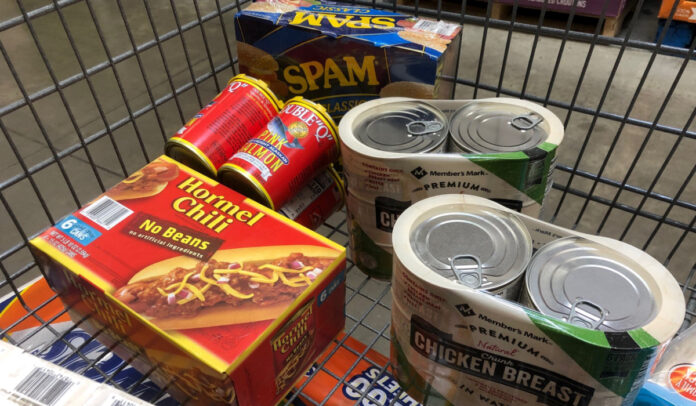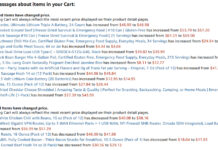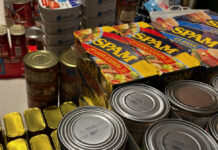
I was in the city yesterday, so I stopped by Sam’s Club and bought the items you see above–six cans of Hormel chili without beans, eight cans of spam, 12 cans of chicken, and four cans of salmon–plus 25 pounds of flour, for $75.98. That’s the most I have spent on my prepper pantry in some time. That’s 30 canned goods for an average cost of $2.23. Take out the salmon, and the cost drops to $2.08 per can. Sounds pretty good, doesn’t it? Until you see the impact inflation has had on those prices, which I will detail below.
Each can of food is between 12 and 15 ounces, so it provides three to four ounces of meat or fish, the central component of a meal, for four people. Note that the meal will also include bread made with our flour or stored wheat, rice, pasta, potatoes, or another item from our long-term storage food. Perhaps some fresh or vegetables or fruit will be available.
Our 30 cans then equal 120 meals, which is a huge amount of food if there are only two of us. The number of meals dwindles as our numbers grow. If we have twelve people living here in a disaster situation, that’s just ten meals. If we spread them out and eat canned meat or fish every third day, all that food will be gone in a month.
Not knowing whether there will be four, or six, or nine, or 12 people at the house after an emergency makes planning difficult. It’s the big unknown. I’d like to think we will have at least eight, a core group that includes my kids. Of course, they live hours away, so it depends on what kind of disaster it is and if cars and gas pumps still work and roads are still open and whether we get warned of an impending disaster, or will it strike suddenly?
Canned Food Costs Up 12 Percent
The canned chicken used to be $9.98 for six cans. It had gone up 18 percent to 11.78. I am glad that I already had seven six-packs on the shelf because that represents a $14 savings.
The bread flour, which was only 8.98 for 25 pounds, had jumped $1 or 12.5 percent since we last purchased it.
Spam was “only” up 6.44 percent, jumping from $19.24 per eight-pack to $20.48. Yes, that’s only 15 cents per can, but I expect it won’t be the last price increase. Meat prices are continuing to climb.
I don’t have a direct cost comparison for the chili because I bought a different brand because of product availability. The salmon was a rare acquisition for me, so I don’t have records reflecting what we last paid for it.
If we consider just those items we can calculate, we see that our average price increase is 12 percent. That’s significant. It means that I paid about $10 more to stock my prepper pantry today than I did back in July.
Not just Prepper Food
Surprisingly, my prepper foods jumped less than our traditional grocery items. Butter, for example, was $10.48 for four pounds, up 34.7 percent from 7.78 earlier this year. Bacon was up 22.5 percent to $5.50 per pound. Hard salami was 15 percent more than I paid in March. Even the tortillas had gone up 10 percent, and I swear they are smaller.
When I compared today’s price for all the grocery items we often buy, I found the cost increases averaged almost 21 percent since the first quarter. This is comparing the same items at the same store. Yikes!
When we look at the entire shopping cart, not breaking out prepper food or fresh food, my costs rose 15 percent since this summer. That is more than I expected. While an item may only go up a dollar, those dollars can add up quickly.
This makes the rumor I reported last week that food prices may rise 30 percent in 2022 seem that much more credible. Check out that article for examples of what we will do to keep our budget under control.






